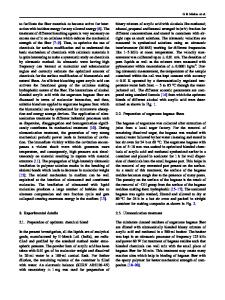Characterization of Airborne Ultrafine and Nanometer Particles During Energetic Material Synthesis and Testing
- PDF / 261,001 Bytes
- 6 Pages / 612 x 792 pts (letter) Page_size
- 96 Downloads / 340 Views
AA1.5.1
CHARACTERIZATION OF AIRBORNE ULTRAFINE AND NANOMETER PARTICLES DURING ENERGETIC MATERIAL SYNTHESIS AND TESTING Meng-Dawn Cheng1 and Charles M. Jenkins2 Oak Ridge National Laboratory1/ESD Building 1505, MS 6038 Oak Ridge, TN 37831 Air Force Research Laboratory2 Munitions Directorate/HERD Eglin AFB, FL 32542 ABSTRACT Several experiments were conducted to improve our understanding of the properties of aerosol particles generated by detonation of conventional explosive and explosives prepared from nanophase materials. Initial number concentrations (~ 106-107 cm-3) of particles produced by detonations of the nano-explosives were comparable to that produced by conventional explosive. In general, data taken by a time-of-flight aerodynamic sizer and a scanning differential mobility analyzer for the first sample indicate a multi-modal distribution that there were a peak between 0.7 and 0.9 µm, and one and/or two peaks smaller than 100 nm depending upon the explosive used. The material properties and formulation of the explosive appear to play a significant role in the enhanced particle growth and increased deposition velocity leading to a higher reduction rate of total particle concentrations. Furthermore, the high level of ultrafine particles and nanoparticles in addition to the enriched toxic metals, the biological properties (e.g., the cellular toxicity) of the detonation particles need to be investigated in the near future. INTRODUCTION Aerosol is a collective term referring to tiny solid and/or liquid airborne particles suspended in the air [1]. An aerosol is an unstable material system with extreme chemical reactivity and population dynamics at production sources, such as detonation of explosives, which produces aerosol particles of diameters smaller than a few micrometers. Nanometer-size particles, or nanoparticles, posses properties not commonly found in larger particles of the same material. Because of the uncommon chemical (high reactivity, high surface energy, etc.) and physical (optical, thermal, electrical conductivity, etc.) properties of materials at a nanometer scale, the term “nanophase” material has been adapted. There is increased use and interest in producing nanophase materials and/or nanoparticles. However, only very limited investigations have been done to understand the biological properties of nanophase materials. Recent research in particle toxicology has focused on ultrafine and nanoparticles as those particles have significantly larger surface areas per unit mass compared to micrometer size particles [2, 3, 4]. The materials present in nanoparticles appear to interact with biological tissues and cells with enhanced reactivity as compared to micrometer-size particles of the same material [5, 6, 7]. Exposure to tens of a nanometer-size Ni, Co, and TiO2 particles has been reported to lead to enhanced production of free radicals on test tissues and animals causing lung inflammation [8]. Nano-Co
AA1.5.2
and Ni are found to have similar ability in producing plasmid free radicals and greater
Data Loading...











